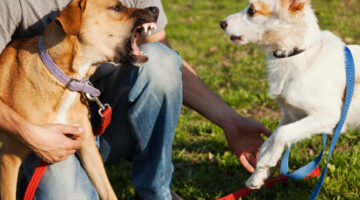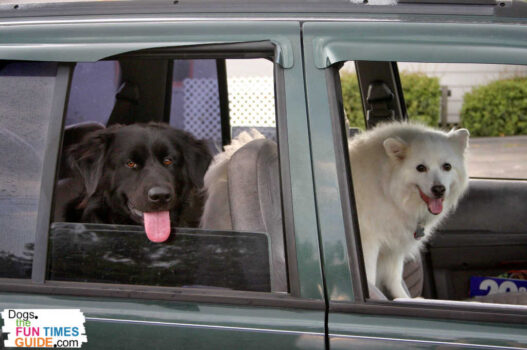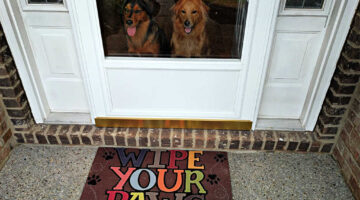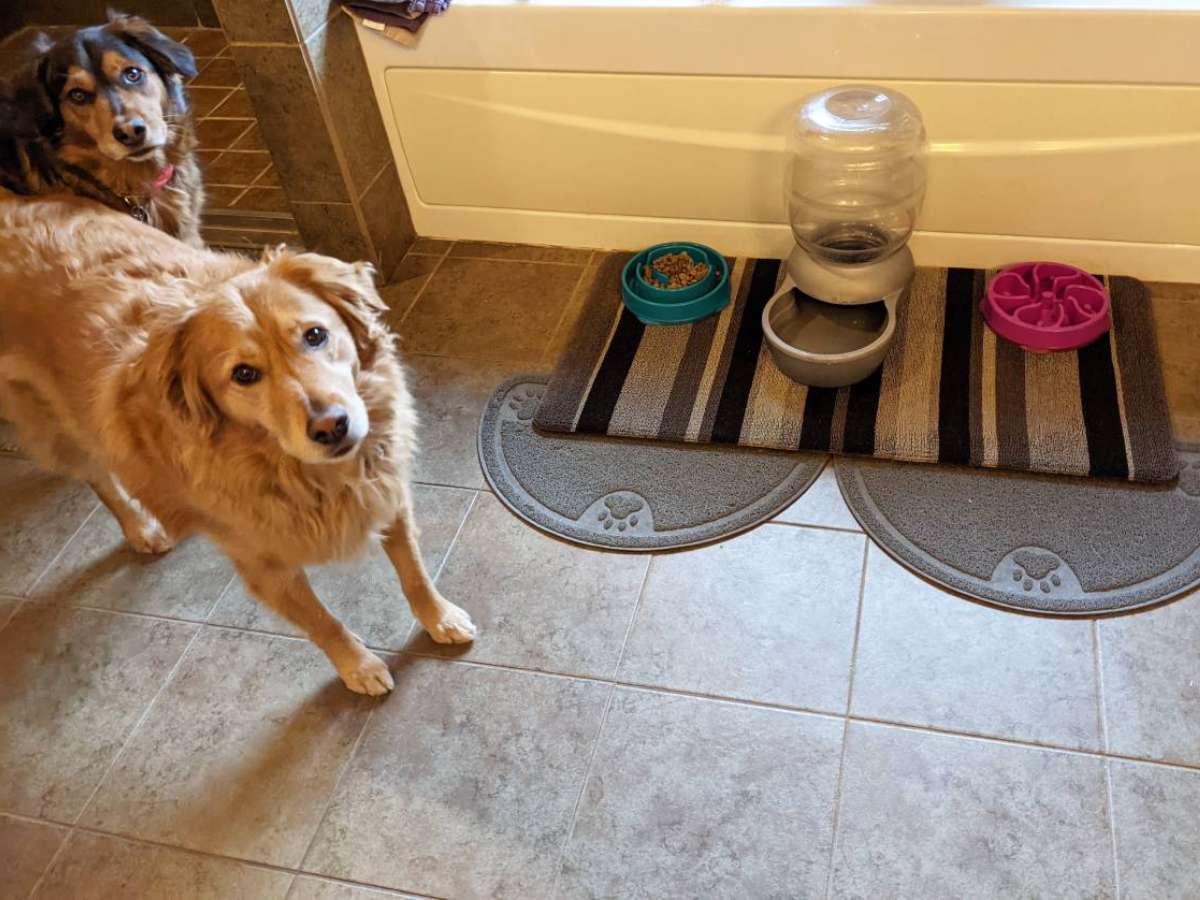Are you considering adding a second dog to your current single-dog household?
Or, maybe you’re thinking of starting out with two sibling dogs?
I’ve done both. In fact, I’ve had two dogs (sometimes three!) at a time living in my home far more often than I’ve had just one dog living under my roof. So I know a little bit about managing a multi-dog household.
Here’s what you need to know about raising more than one dog at a time — along with all my best tips for living peacefully with more than one dog in your house!
What Are The Odds Of Two Dogs Not Getting Along?
The likelihood of two or more dogs to not get along depends mostly on the dogs themselves and their unique personalities.
Scientific research published in the American Veterinary Medical Association journal found that two male dogs are more likely to have a peaceful co-existence than two female dogs. The study showed that:
- 32% of aggressive incidents were between two males
- 68% of aggressive incidents were between two females
The team at We’re All About Pets told us that these findings are consistent with previous research — which found male dogs to be more accommodating than females.
That said, even if you do everything right… there is still a good chance that both dogs will not get along.
However, as time passes (and as long as you’re patient), a conflict-free home can still be achieved!
Must read: Aggression Between Dogs In The Same Household
Can Two Male Dogs Get Along?
Although female pairs are the most challenging to befriend one another, raising two male dogs can also be difficult at times.
It’s important to note that aggression between male dogs is common — especially when they share a home.
So, you will have to be particularly attentive, in order to observe any signs of hostility before things between your two male dogs get out of hand:
- Take the time to learn the cues that would indicate your dogs are getting ready to fight — including:
- a stiff, raised tail
- raised hair on the back of the neck
- even just a certain glance or way that the dominant dog looks at the other (submissive) dog
- Exercise your dogs regularly — to reduce tension and eliminate any built-up frustration.
- Separate your dogs when necessary — whenever you’re not home and any time that you cannot watch them closely when they’re in the same room together. (Especially throughout their entire first year together… until you can be sure how well they really get along in a variety of scenarios.)
See what happened when our adult male dog was aggressive with our new male puppy.
Can Two Female Dogs Get Along?
Male-female combinations often work better — but if you want a pair of female dogs, you have to be ready to put in the extra work.
Same-sex dogs, especially females, tend to feel more pressure to assert themselves as the dominant dog (or alpha) in the pack — which can lead to fights.
Female pairs are often aggressive, particularly if they’re approximately the same age. (Yes, even if they are raised together.)
Still, female dogs can get along. You just have to take things slow!
Here is the best way to introduce two dogs:
- Begin introductions on neutral ground — in a park, a friend’s yard, or any other location away from your house. Keep in mind, it might not work the first time. Some dogs have to get to know one another on a gradual basis (through several meetings) before becoming “friendly.” By all means, do not force the dogs to get along quickly — that will only create problems later.
TIP: Do not hold one of the dogs in your arms while introducing them to the other dog! - Have each dog on a separate leash, with a grown adult holding firmly onto each leash. Start with the dogs far apart — and observe their reactions as you walk them closer together. Do not force the dogs together in any way — just let them figure it out on their own.
TIP: Most dogs will have no issues, but you still need to be prepared — just in case an issue arises. Know how to take control of the situation, if either dog becomes aggressive. - If you happen to notice signs of aggression while introducing two dogs… without causing a commotion or making a big deal of it, slowly move the dogs a little bit farther apart.
TIP: Professional obedience training to fine-tune the dogs’ behavior is more important than ever when you’re raising two female dogs!
Best Dog Breeds For A Multi-Dog Household
If you’re wondering what are the best dogs for a multiple dog household, you’ve come to the right place.
While it ultimately depends on both dogs’ unique upbringing, personality, and life experiences, the following dog breeds tend to get along with other dogs better than most.
The Top 10 (in alphabetical order):
- Beagle
- Bernese Mountain Dog
- Cavalier King Charles Spaniel
- Golden Retriever
- Great Pyrenees
- Havanese
- Labrador Retriever
- Puggle
- Samoyed
- Siberian Husky
Are Puppy Siblings Easier To Raise Together Than Dogs Of Different Ages?
The short answer: No.
In fact, raising two dogs at the same time when they’re both under 6 months of age is one of the most challenging situations you can enter into — whether they’re from the same litter or not.
Why?
Because of something called Littermate Syndrome. This is where puppies (from the same litter or completely different litters) that are raised together become overly attached to one another — to the extent that they don’t respect you (or anyone else) as their real pet parent or “leader.”
If puppies are not separated for much of the time during their first 6 months of life, they will be negatively impacted in these ways:
- They become very fearful whenever they’re apart from each other — to the extent that they can’t do anything on their own.
- They become overly dependent on one another — and lack self-confidence
- They become extremely rebellious together — and difficult to train.
- They become more aggressive — toward each other, other dogs, and people.
Littermate Syndrome is a serious concern any time you are raising two young puppies at the same time. This is true even if you have two non-sibling dogs in your home when they’re both under 6 months of age!
And… you will have an uphill battle trying to establish and maintain a quiet and peaceful home with these two dogs.
Must read: My Experience With Littermate Syndrome – What To Expect If You Adopt Sibling Puppies
The bottom line when raising two puppies together is: you need to do everything in your power to reduce the effects of Littermate Syndrome during the first 6 months of your puppies’ life. (See my tips in the above article. I’ve successfully raised two sibling pups through their littermate issues — and they are now 3 years old.)
Okay, so at this point, you probably know whether you’re planning to:
- Adopt a second dog that is male; or
- Adopt a second dog that is female; or
- Adopt sibling puppies from the same litter.
Now, it’s time to weigh all of the pros and cons of having two dogs, regardless of their age!…
Benefits Of Having Two Dogs
Having more than one dog living with you definitely has its downsides (see below) — however, it can be lots of fun and rewarding too!
These are the 7 biggest benefits of having more than one dog in your home:
#1 – There’s more love to go around in a multi-dog household — more companionship for you and the rest of the family. (One of the best benefits of raising two dogs together, in my opinion.)
#2 – The dogs always have a playmate and snuggle buddy — leaving you free to do other things much of the time. (Playing with two dogs takes a fair amount of time. And there’s no way I could give my two dogs as much exercise as they give each other running around our yard several times each day!)
#3 – It’s been proven that having a dog improves your mood and your overall health — having two dogs can double the effects! (As long as you stay on top of the dog training in a multi-dog household.)
#4 – One well-mannered dog could be a good influence on the other dog. (In our case, our senior dog was a great role model and helped shaped the behavior of our 2 youngest pups!)
EXAMPLE: Our senior dog couldn’t walk up stairs anymore, so he stopped going upstairs every time we went upstairs. Since our sibling puppies witnessed this behavior from day one in our house, they have never attempted to go upstairs to our second level — even though they’re now 3 years old and the senior dog has been gone for over 1 year!
#5 – If the dogs are close in age and you’re attempting to train them both at the same time, one dog that learns quickly could make training easier with the other one — since dogs tend to mimic each other. (In this sense, training more than one dog can be beneficial.)
#6 – More dogs are always better than one if security is a concern –because dogs are naturally protective of their owner, and entire family. (So more barking occurs and more rooms of the house can be protected when you have more than one dog.)
#7 – If you get the second dog toward the end of your senior dog’s life, it will be easier for you to deal with the grief and loss of your senior dog when you have another dog to help you take your mind off of it. (This has always been the reason I’ve gotten involved with raising two dogs vs. one.)
NOTE: While they say this should never be the primary reason for getting a second dog (because you just never know how the dogs will get along, and you could be creating more trouble than it’s worth AND it could make your senior dog feel slighted, since they’ll no longer be receiving 100% of your attention)… I have always done it. I don’t just hastily run out and get another dog, but I open my eyes to dogs in need that I think would fit into well our family. I simply can’t bear living in a quiet, empty house. I need to always have a dog in my life. And that’s how we came upon our current pups! We were motorcycling in another state, and we saw them dumped on the side of the road. We thought about it for a minute and realized… while we hadn’t been planning to add two dogs to our single-dog family, our senior dog might enjoy the company and we might adjust better when he left us. So we scooped them up, put them in a Walmart reusable shopping bag, and rode the 2 hours home with them nestled between my husband (driving) and myself (on the backseat). The three dogs lived almost one year together, before our senior dog passed at the age of 14 years.
Downsides Of Having More Than One Dog
Having multiple dogs at home can be fun and rewarding, but it also demands a lot of hard work and time. Trust me on this — especially if you work outside the home!
Here are the 7 biggest downsides of bringing another dog into your home:
#1 – Dog training is twice as hard.
It’s challenging enough to train one dog, let alone two or more! Dog training requires dedicating 100% of your attention to one dog at a time.
When training two dogs, you will have to:
- Put up with one or both dogs’ barking, crying, and being frustrated that they’re not included.
- Be prepared for the double mess — especially when it comes to potty training.
- Spend twice as much time teaching your dogs basic manners (puppy commands).
#2 – Feeding multiple dogs can be challenging… and time-consuming.
It’s not uncommon for one of your dogs to be a food hog (that gulps down as much food as they can, as quickly as they can) or a resource hoarder (that is overly protective anytime another dog or person gets near their food bowl).
You can manage this conflict by feeding each dog in a separate dog crate or in a separate room.
Also, feeding your dogs directly from your plate is a big NO-NO, as it only sets the field for more conflict. The more you stick to your guns on this (especially when you have two dogs!), the more peaceful your meals will be.
#3 – Sleeping requires more space (especially for large dogs) — since you need to have two separate sleeping areas for them.
At the very least, each dog needs a “space” where they can go to feel safe and call their own. This could be separate dog beds, or separate dog crates. (I always use separate crates until my dogs turn 1 year of age… at least. My two current pups stayed in crates for almost 2 years.)
If you intend to have your two dogs sleeping with you in the bed, I recommend getting your dogs used to a specific command (like “up on the bed”) — and ensuring that they never get on your bed without hearing that phrase first. Be consistent! (The dogs that cohabitate with humans best are those that always know what’s expected of them.)
If your dogs won’t settle down enough to go to sleep when you want to at night, I recommend using dog crates. They have no choice but to “settle” there, and they will quickly get used to having their own space this way. (Remember, dogs like dens …even if they fight you on it the first several times!)
Here are some crate ideas for two dogs — even crate ideas for multiple dogs (both indoor and outdoor).
#4 – Walking two dogs will be a pain, initially.
Because, at first, each dog will want to go their own way! And using separate leashes for each dog isn’t all that easy for one person to do.
However, it is relatively easy to train two dogs to walk on a leash without pulling — just as you would with one dog.
And it’s even easier when you use just one leash with a coupler that makes it much easier to walk multiple dogs at the same time.
#5 – Barking can be an issue, with more than one dog in the house.
If you think one dog barking is a nuisance, imagine two dogs doing it simultaneously!
I’ve found that one dog will often set off the other dog — meaning just because one dog saw or heard something and started barking, the other one will automatically chime in by barking as well.
#6 – Going places takes more preparation (and time) at first.
You have to remember to pack all the necessities — not just for one dog, but for two dogs.
So there’s double the amount of dog gear (leashes, water bowls, poop bags, snacks, towels, etc.)
Not to mention double the dog fur, double the dog drool, and double the dirty and muddy paw prints! (I got a dog car seat hammock to help with most of that — now my car stays much cleaner.)
Plus, car trips can take much longer due to potty breaks, the time to stretch their legs, and exercise needs — to prevent your dogs from getting too antsy due to being cooped up in the car for so long.
#7 – It’s more expensive to maintain a multi-dog household.
You have to:
- Buy two of almost everything as far as dog gear & supplies goes — dog beds/crates, dog bowls, dog toys, etc.
- Spend twice as much time at the vet on routine checkups. Plus, two dogs means twice the likelihood that you’ll have a sick or injured dog on your hands at any given time.
- Buy double the amount of dog food and dog treats — remember, it’s not about the brand you buy, it’s about the ingredients. And sometimes the “better” ingredients aren’t cheap.
TIP: See how I save money on dog treats! - Spend twice as much money on vet care — from routine visits to annual prescriptions (like heartworm, flea, and tick preventatives).
- Clean the house a lot more — which means more (and better) cleaning supplies. (It’s not easy keeping your floors and carpets free of all that mud, dirt, and fur. A good mop and a vacuum cleaner that’s good with pet hair aren’t cheap!)
- Spend more money on pet sitting — whether you’re taking your dogs to doggie daycare for the afternoon, boarding them overnight, or hiring someone for in-home pet sitting while you’re out of town.
Not A Positive Or A Negative — Just A Fact Of Life
In addition to the pros and cons of having two dogs that are mentioned above, here’s something that has its good points and bad points…
If one dog escapes (the yard, the front door, or the car), you will have two lost dogs on your hands — because one never goes anywhere without the other.
On the plus side, sometimes two dogs are easier to spot than just one!
But then you have the issue of corralling them to safety together — when one wants to venture further away from home to explore some more and the other wants to “be a good girl” and “come” because you’re calling her and she’s knows it’s the right thing to do.
In my case, our male pup is a lot more adventurous than the female — so she is usually the one who wants to come to us, but he likes to test the limits of his freedom!
Unfortunately, I happen to have a lot of experience with this — because the lawn maintenance guys have left our backyard gate open on more than one occasion.
Fortunately, our dogs have never wandered too far beyond our own neighborhood. They always have their collars on (with ID tags that our number and the vet’s phone number engraved on them), and they’re both microchipped — so those things give us some peace of mind as well.
TIP: Do these things now, just in case your dog ever happens to get away from you!
Gear & Supplies That Can Simplify Living With More Than One Dog
These are a few of the things that have made my life with 2 dogs much easier:
- A double dog leash – An adjustable double dog leash makes it easy to walk two dogs at the same time! Look for one that has a swivel attachment point — that way the leash will always remain tangle-free should one dog switch sides with the other one while walking.

- A feeding and watering station (or at least separate bowls) – In the past when I had two dogs at the same time, I had separate feeding areas for them altogether (separate food & water bowls in different rooms). With our two sibling pups, we dole out a specific amount of dog food twice a day for each pup in a separate bowl. (I use puzzle dog bowls — otherwise, they gulp their food too quickly! One is the “purple flower” and the other is “turquoise drop.”) And a 2.5-gallon gravity waterer separates the two dog bowls. This automatic watering station has been a lifesaver — because two dogs drink a lot of water. And now I only have to refill the dog water tank once a week or so, rather than refilling two individual water bowls several times each day!

- Two separate dog beds or crates – We always use these dog crates for the entire the first year (at least) for all of our dogs. Then, we switch to these XL dog beds after that. You want to provide a separate sleeping area for each dog in the household for these reasons:
- Helps prevent Littermate Syndrome with young puppies that get so close that their cognitive, behavioral, and emotional growth is affected.
- Allows each dog become more confident and self-sufficient. You don’t want one dog to have a meltdown if they ever have to be separated from their sibling… or become aggressive if one of them has an item that the other one doesn’t. (Having a crate to call their own is something that all of my puppies have always grown accustomed to very quickly.)
- Makes it easier to train more than one dog. Having a safe and comfortable place to put one dog while working on training cues with the other has been a lifesaver for me! Despite their initial whining and/or barking, dogs actually like having a place that is their own — it’s like their “dog den” where they feel safe and comfortable. (So don’t feel like you are punishing your dog by putting them in their crate!)
- Gives each dog their own relaxing “space” in the home. This is incredibly helpful if one dog should ever become scared or anxious at certain times (like when guests arrive, during fireworks, if they have to be separated from their sibling after a spay/neuter, etc).
The Takeaways
There are good things and bad things about raising two dogs at the same time.
While some of the downsides to having more than one dog can seem downright scary, many people still opt for a getting a second — because they like the additional companionship and avenues for socialization that multiple dogs provide.
Just remember that having a trouble-free multi-dog household relies getting several things “right” the first time:
- You need to introduce the dogs to one another properly.
- Know the signs that dogs give when they don’t like another dog.
- Make sure that your dogs always get enough exercise — so they’re able to burn off their energy and frustrations.
- Take advantage of unique products that were designed to make life with two dogs much easier.
- With sibling puppies, in order to reduce the effects of Littermate Syndrome, you need to commit to doing almost everything with them individually (separately) for their first 6 months in your home.
The bottom line: If you’re going to have two dogs in the house at the same time (regardless of whether they’re males or females), the best thing you can do is bring them into home when they’re at least 6 months apart in age. Or, wait to get a second dog until your first dog has turned 6 months of age… or older.
A good read: Is Getting A Second Dog The Right Thing To Do?
Dig Deeper
Here are the things you absolutely must do when you have two or more dogs!
These are my best tips for training two dogs.
And finally… my friend has two large dogs and she’s really handy with DIY projects. She made this DIY dog tie-out for multiple dogs when you don’t have a backyard fence. And these no-sew XL dog beds that are way cheaper than buying orthopedic dogs beds.
Like this post? Save it to read again later… or share with others on Pinterest!















